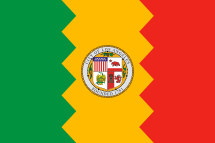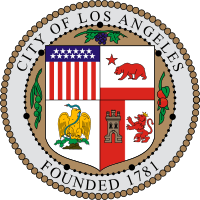Edward Falles Spence
| Edward Falles Spence | |
|---|---|
 Portrait of E. F. Spence | |
| 17th Mayor of Los Angeles | |
|
In office December 9, 1884 – December 14, 1886 | |
| Preceded by | Cameron E. Thom |
| Succeeded by | William H. Workman |
| Personal details | |
| Born |
December 22, 1832 Enniskillen, Ireland |
| Died |
September 19, 1892 (aged 59) Los Angeles, California |
Edward Falles Spence, known as E.F. Spence, (December 22, 1832 – September 19, 1892) was a California banker, entrepreneur and property developer who was a member of the state legislature, a Nevada County official and the mayor of Los Angeles, California, in 1884–86.
Personal
Spence was born on December 22, 1832, in Enniskillen, Ireland, the son of Gabriel Spence. He was educated there by private tutors, and at the age of 20 he emigrated to America and worked on a farm near Philadelphia, Pennsylvania, for several months, then shipped to California via the Nicaragua route, arriving in San Francisco in December 1852. He spent some twenty years in Northern California and Nevada, settling in San Jose, California.[1]
He was married about 1869 in California to Anna Maria Spence of Five Mile Town, County Tyrone, Ireland, and they had four children, William Glenn, George Edward, Albert Harry and Kathleen.[1]
Spence died of heart failure September 19, 1892, in the home of a friend, John A. Fairchild, on Burlington Avenue[2] near Ninth Street, in today's Westlake district, Los Angeles. He was 59 years old.[3] The September 22 obsequies, which began in the family home on Burlington Avenue, were said to be "in point of attendance one of the largest ever held in this city" and the funeral procession to Evergreen Cemetery "one of the largest ever witnessed."[4]
Vocation
Spence gained his knowledge of business affairs through assisting his father in the management of the family's large farming tracts and herds of cattle in Ireland. He engaged in mining In Northern California and Nevada, but in San Jose he "controlled an extensive drug business" and then switched to banking. As well, he was one of the organizers of the Commercial Bank of San Diego.[1]
In 1875 Spence was named cashier of the Commercial Bank of Los Angeles, organized by John Edward Hollenbeck and reorganized in 1880 as the Commercial State Bank, the forerunner of the First National Bank of Los Angeles, of which Spence became president in 1881. He held interest in other banks as well, and owned property in Whittier and Monrovia, California.[1]
Spence was also responsible for building the first horse car line across the Los Angeles River and, in 1886, financing the first electric car line in Los Angeles.[1]
Public service
A Republican, Spence was elected to the California State Assembly from Nevada County in 1860[5] and was later the treasurer of that county.[6]
On December 5, 1979, Spence was elected to represent the 3rd Ward on the Los Angeles Common Council, the legislative branch of the city government, and he served until December 10, 1881.[7]
He was mayor of the city from December 9, 1884, to December 14, 1886, and under his mayoralty the city reorganized the Police Department and the Fire Department and placed all the personnel on salary. In his final year as mayor, the city retired its last zanja, or open fresh-water ditch.[1]
University of Southern California
Spence was one of the founders of the University of Southern California,[8] which was then called Methodist College, and he was on its board of directors.[1] He promised to donate some of his property, "including the lot at the corner of Pearl and Sixth streets (on which the Gates Hotel now stands)" to USC so that it might be sold and the proceeds used to place a telescope on the summit of Mount Wilson. University President Marion M. Bovard ordered a lens from the Cambridge manufactory Alvan Clark & Sons, but Spence died before the deal could be completed, so Bovard had to sell the glass to the University of Chicago.[9] Another source said that Spence had agreed to give the cash sum of $50,000 to fund the telescope project,[6] but it was later reported that the gift was indeed in the form of land that eventually lost its value and the USC contract with "a French firm for a forty-inch telescope, the largest in the world," had to be canceled.[10]
References and notes
Access to the Los Angeles Times links may require the use of a library card.
- 1 2 3 4 5 6 7 Clare Wallace, Los Angeles Public Library biographical file, with references as cited there
- ↑ Location of the Spence home on Mapping L.A.
- ↑ "A Public Loss," Los Angeles Times, September 20, 1892, page 4
- ↑ "Laid to Rest: Impressive Funeral Services of the Late E.F. Spence," Los Angeles Times, September 23, 1892, page 4
- ↑ E.F. Spence, JoinCalifornia.com
- 1 2 "A Leading Citizen Stricken Down," Los Angeles Times, September 20, 1892, page 4
- ↑ Chronological Record of Los Angeles City Officials,1850-1938, compiled under direction of Municipal Reference Library, City Hall, Los Angeles (March 1938, reprinted 1966). "Prepared ... as a report on Project No. SA 3123-5703-6077-8121-9900 conducted under the auspices of the Works Progress Administration."
- ↑ "Final Rites Held for Anna M. Spence, Ex-Mayor's Widow," Los Angeles Herald-Express, June 26, 1937 (scroll down)
- ↑ Harris Newmark, Sixty Years in Southern California (1916),
- ↑ "The Spence Observatory," San Francisco Post, reprinted in Los Angeles Times, December 13, 1896, page 19

